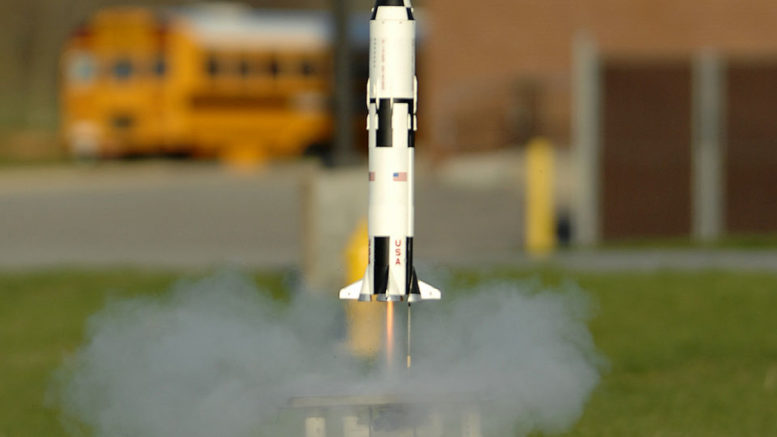Many people are interested in model rockets, but what are they exactly? How do they vary and how did model rockets become so popular?
A model rocket is a small rocket designed to reach low altitudes and be recovered by a variety of means. The typical construction material for model rockets include paper, wood, plastic and other lightweight materials. The United States National Association of Rocketry Safety Code is a code developed by and used by US NAR members that provides guidelines for motor use, launch site selection, launch methods, launcher placement, recovery system design and deployment and more. Since the 1960s, a copy of the Model Rocket Safety Code has been provided with most model rocket kits and motors.
Model Rocket History
The earliest and first model rockets were seen in the early thirteenth century when the Chinese turned black-powder–propelled objects into weapons of war. This meant that the Chinese ‘arrows of fire’ were fired from a sort of catapult launcher with the black powder packed in a closed tube with a hole in one end for escaping hot gases, and a long stick as an elementary stability and guidance system.
In 1591, Jean Beavie, described and sketched the important idea of multistage rockets. This is important because multi staging is the practical answer to the problem of escaping earth’s gravitational attraction. The model rocket motor, was designed in 1954 by Orville Carlisle. With the launch of Sputnik, interest in model rocketry skyrocketed. It was around this time that Vernon Estes founded Estes Industries in 1958 in Denver, Colorado, which would becoming the largest model rocket company by market share.
Model rocket recovery methods
- Featherweight Recovery is the simplest approach, which is appropriate only for the tiniest of rockets. This method lets the rocket flutter back to the ground after ejecting the motor.
- Tumble Recovery has the rocket tumble back to earth.
- Nose-Blow Recovery is where the ejection charge of the motor ejects the nose cone of the rocket from the body tube. Nose-blow recovery is generally only suitable for very light rockets.
- Parachute/Streamer uses the ejective force of the motor to deploy, or push out, the parachute or streamer. The parachute is attached to the body either directly, by means of a ripcord, or indirectly, when it’s attached to the nose cone, which attached to the body by a ripcord.
- Glide Recovery sees the ejection charge either deploys an airfoil or separates a glider from the motor. If properly trimmed, the rocket/glider will enter a spiral glide and return safely.
- Helicopter Recovery sees the ejection charge, through one of several methods, deploys helicopter-style blades and the rocket autorotates back to earth.
Motor nomenclature
- First letter indicates the motor’s total impulse range, measured in newton-seconds. Each letter in successive alphabetical order has up to twice the impulse of the letter preceding it.
- First number indicates the motor’s average thrust, measured in newtons.
- Last number is the delay in seconds between the end of the thrust phase and ignition of the ejection charge.
High-Power Model Rockets
A high-power rocket must meet at least one of the following criteria:
- The rocket weighs more than 1,500 grams
- The motor used contains more than 125 grams of propellant
- The motor used has an impulse of more than 160 Newton-seconds (is an H-class or above) or uses multiple motors with a total impulse of more than 320 Newton-seconds.
- Exact requirements vary from one jurisdiction to another.
These requirements are required because these rockets need to withstand the higher stresses during flights that often exceed speeds of Mach 1 (340 m/s) and over 3,000 m (9,800 ft) altitude. Moreover, with this speed and altitude and potential risk to other aircraft, the owner of the high powered model rocket needs to often coordinate with proper authorities, such as the aviation authorities and land owners. Benefits of these rockets is that they. are larger, reusable, and can carry large payloads, including cameras and instrumentation such as GPS units.
These rockets do make amazing holiday gifts for those in your life who might be looking for a new hobby, plus have the ability to launch them. The biggest hurdles to getting into the model rocket hobby would be the logistics space regarding launch these model rockets and have the expertise to retrieve the rocket successfully to be able to recover the rocket for future flights.
References And Further Reading
https://estesrockets.com/product-category/rockets/

Be the first to comment on "Model Rockets"